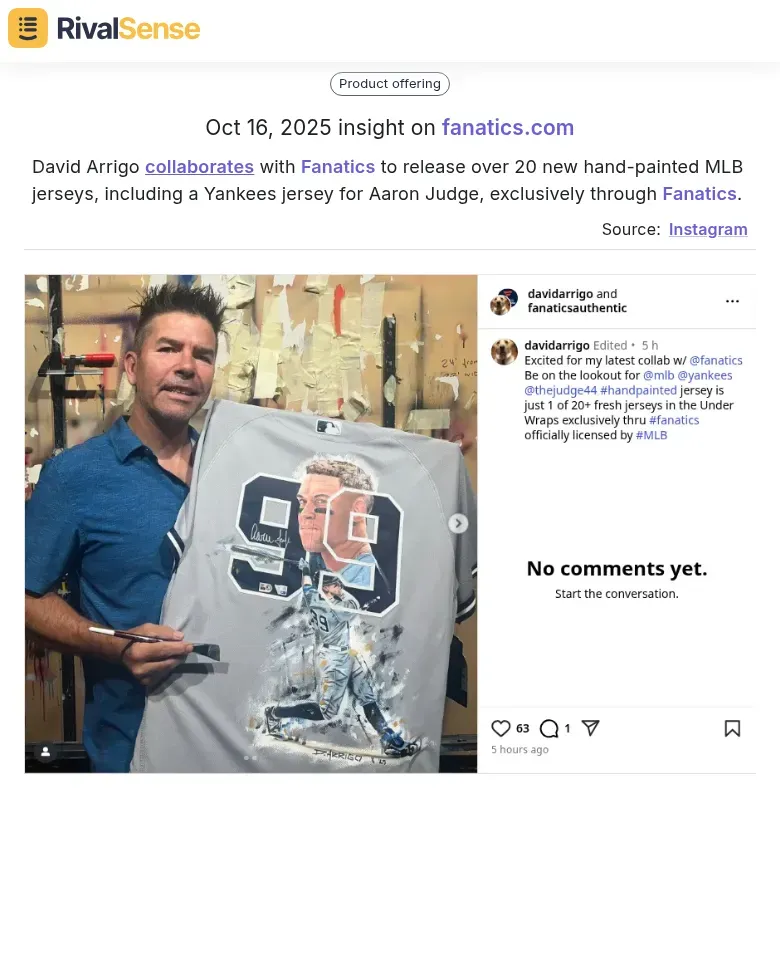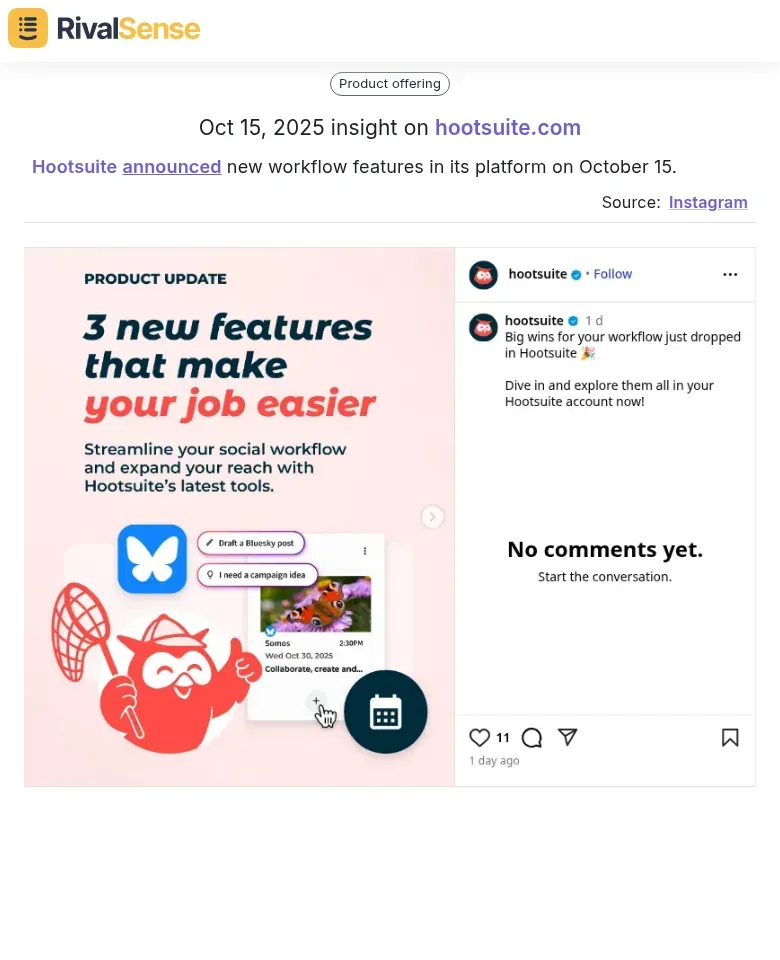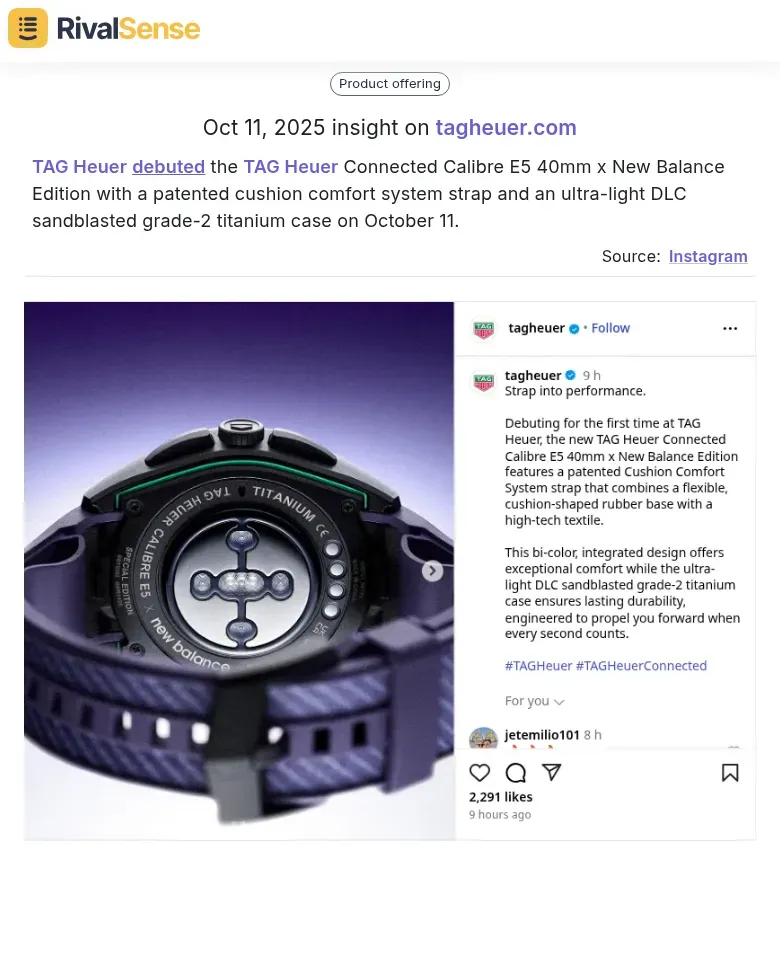Optimize Competitor Insights from Instagram Thought Leadership
Instagram thought leadership offers a goldmine for competitive intelligence that traditional analysis often misses. Unlike corporate websites or press releases, Instagram reveals authentic positioning, expertise depth, and audience engagement in real-time. Thought leaders share industry insights, strategic thinking, and behind-the-scenes expertise through visual content—stories, reels, and posts—making abstract concepts tangible and memorable. This provides unique competitive insights into how rivals position themselves, what expertise they emphasize, and how they build authority.
Monitoring competitor thought leadership on Instagram gives you a strategic advantage. You can identify emerging trends they're capitalizing on, gauge their content resonance through engagement metrics, and uncover gaps in their messaging that your brand can fill. For instance, if a competitor's carousel posts on AI ethics receive high saves, it signals audience interest you can leverage.
Instagram's visual platform amplifies thought leadership impact. Videos and infographics simplify complex ideas, fostering deeper connections. Here's a practical checklist to get started:
- ✅ Identify key competitors and their thought leaders.
- ✅ Track content themes like industry insights, product updates, or customer stories.
- ✅ Monitor engagement metrics such as likes, comments, and shares.
- ✅ Use tools like RivalSense to automate tracking and spot patterns.
This approach turns casual scrolling into actionable intelligence, helping you refine your strategy and stay ahead. 🚀
Analyzing Strategic Partnerships and Collaborations
Strategic partnerships and collaborations are key indicators of a competitor's growth strategy and market expansion efforts. By monitoring these on Instagram, you can identify new opportunities and potential allies in your industry. For example, tracking co-branded posts or joint campaigns reveals how competitors leverage alliances to reach new audiences.
RivalSense recently captured that David Arrigo collaborated with Fanatics to release over 20 new hand-painted MLB jerseys, including a Yankees jersey for Aaron Judge, exclusively through Fanatics.  This type of insight is valuable because it shows how exclusive partnerships can create buzz, tap into niche markets, and enhance brand credibility—strategies you can adapt to forge your own successful collaborations.
This type of insight is valuable because it shows how exclusive partnerships can create buzz, tap into niche markets, and enhance brand credibility—strategies you can adapt to forge your own successful collaborations.
Learn from exclusive product launches and limited editions, as competitors often use these to test demand or reward loyal followers. Note how they announce these—through Instagram Stories, live videos, or countdowns. Emulate their urgency tactics, like limited-time offers, to boost your own launches.
Understand how brand alliances expand reach and credibility. When competitors partner with trusted names, they borrow authority. Analyze the audience overlap and engagement rates of these collaborations. Apply this by seeking partners who share your values but target different segments, widening your influence.
Practical Tips:
- 🗓️ Create a daily checklist to monitor competitor tags, hashtags, and mentions.
- 📊 Steps: Identify 3-5 key competitors; track their collaboration history monthly.
- 💡 Hint: Use Instagram Insights to see which partnerships drive the most saves or shares.
- 🤝 Advice: Start small with micro-influencers before scaling to larger alliances.
Monitoring Product Innovation and Feature Announcements
Monitoring competitor product innovation on Instagram provides real-time insights into market trends and customer preferences. It allows you to stay ahead by anticipating shifts in industry standards and adapting your offerings accordingly. Track feature announcements by following competitor accounts and enabling post notifications to catch updates as they happen.
Analyze how they communicate updates—do they use Reels for demos, Stories for teasers, or carousels for detailed breakdowns? For instance, RivalSense tracked that Hootsuite announced new workflow features in its platform on October 15.  This insight is valuable because it highlights how competitors enhance user experience and operational efficiency, enabling you to benchmark your product roadmap and identify areas for improvement.
This insight is valuable because it highlights how competitors enhance user experience and operational efficiency, enabling you to benchmark your product roadmap and identify areas for improvement.
Practical steps: Create a tracking spreadsheet with columns for feature type, launch date, and engagement metrics. Use Instagram's search function with hashtags like #[CompetitorName]Launch to catch announcements. Learn from their workflow improvements—if a rival posts about a streamlined onboarding process, assess how you can enhance your UX.
Checklist for weekly monitoring:
- 🔍 Monitor new posts and Stories for feature teasers.
- 💬 Analyze comment sentiment to gauge customer reactions.
- 📝 Document key takeaways for product development meetings.
- 📈 Compare engagement rates to identify high-performing content formats.
This approach turns Instagram into a strategic intelligence tool, helping you refine your product strategy and respond swiftly to market changes. ⚙️
Extracting Insights from Premium Product Positioning
Premium product positioning on Instagram reveals how competitors build perceived value and justify higher price points. By analyzing their visual and textual cues, you can decode strategies that attract discerning customers and differentiate from mass-market alternatives. Luxury brands often use scarcity, heritage storytelling, and aspirational lifestyles to create exclusivity.
For example, a tech company might showcase exclusive materials like aerospace-grade aluminum or patented cooling systems. RivalSense recently noted that TAG Heuer debuted the TAG Heuer Connected Calibre E5 40mm x New Balance Edition with a patented cushion comfort system strap and an ultra-light DLC sandblasted grade-2 titanium case on October 11.  This insight is crucial because it demonstrates how material innovation and limited editions can elevate brand perception, offering lessons for your own premium positioning efforts.
This insight is crucial because it demonstrates how material innovation and limited editions can elevate brand perception, offering lessons for your own premium positioning efforts.
Analyze competitors' posts for material innovation—note mentions of sustainable sourcing, durability claims, or unique textures. Design differentiation is key: look for minimalist aesthetics, custom color palettes, or ergonomic features highlighted in visuals. Technical specifications become selling points; track how competitors translate complex specs into relatable benefits like 'all-day productivity' or 'seamless multitasking.'
Checklist for premium positioning analysis:
- 1️⃣ Identify premium keywords (e.g., 'crafted,' 'elite') in captions.
- 2️⃣ Compare product imagery for design consistency and aesthetic appeal.
- 3️⃣ Note unique features competitors emphasize repeatedly.
- 4️⃣ Use Instagram's 'Saved' collections to categorize insights by theme (e.g., materials, tech specs).
Practical tip: Regularly review these insights to uncover competitive advantages and refine your own value proposition. 💎
Developing Actionable Competitive Intelligence Frameworks
To systematically track competitor thought leadership on Instagram, start by creating a structured framework that organizes data for easy analysis. This framework helps you spot trends, identify patterns, and make informed strategic decisions based on reliable insights. Begin by identifying key competitors and categorizing their content themes—such as industry insights, product updates, or customer stories.
Use tools like RivalSense to automate tracking of posts, stories, and engagement metrics, setting up alerts for new content to stay current. Translate insights into strategic decisions by analyzing patterns; for example, if a competitor's thought leadership on sustainability drives high engagement, consider how your brand can address similar topics authentically.
Build a competitive intelligence dashboard for ongoing monitoring, including metrics like follower growth, engagement rates, and content frequency. Tools like Google Sheets or specialized software can visualize trends, making it easier to share findings with your team. Regularly review the dashboard in meetings to inform marketing campaigns and product development.
Practical steps for implementation:
- 🎯 Define tracking goals (e.g., monitor for partnership opportunities or feature launches).
- 👥 Select 3-5 key competitors to focus your efforts.
- 🔧 Set up monitoring tools like RivalSense for automated insights.
- 📊 Analyze data weekly to stay agile and responsive.
- 💬 Incorporate qualitative insights (e.g., audience sentiment) alongside quantitative data.
- 🔄 Update frameworks quarterly to adapt to market changes and new competitors.
This structured approach ensures that your competitive intelligence efforts are consistent, actionable, and aligned with your business objectives. 📋
Implementing Competitive Insights into Your Instagram Strategy
To implement competitive insights into your Instagram strategy, start by analyzing competitor tactics that resonate with your target audience and align with your brand values. This proactive approach ensures your content remains relevant, engaging, and differentiated in a crowded market. Adapt successful elements like content formats or engagement techniques, but always infuse your brand's unique voice to maintain authenticity.
For example, if a competitor's carousel posts drive high engagement, create your own version with your brand's perspective and storytelling. Identify gaps in competitor strategies by monitoring what they're not addressing—look for underserved topics, unmet audience needs, or engagement opportunities they're missing. This reveals white space for differentiation, such as focusing on customer success stories if competitors emphasize product features.
Measure impact by tracking key metrics before and after implementing competitive intelligence. Monitor engagement rates, follower growth, website traffic from Instagram, and conversion rates to assess effectiveness. Use tools like RivalSense to automate competitor tracking and benchmark your performance against industry leaders, ensuring you stay competitive.
Practical checklist for ongoing implementation:
- 📅 Conduct weekly competitor content audits to spot new trends.
- 🧪 A/B test adapted tactics to see what works best for your audience.
- 📈 Track 3-5 key performance indicators (KPIs) like engagement rate and lead generation.
- 🔍 Perform quarterly gap analyses to identify new opportunities.
- 🛠️ Refine strategy monthly based on fresh insights and performance data.
By consistently applying these steps, you can turn competitive intelligence into a powerful driver for growth and innovation on Instagram. 🌟
Ready to take your competitor tracking to the next level? Try RivalSense for free at https://rivalsense.co/ and get your first competitor report today! RivalSense tracks competitor product launches, pricing updates, event participations, partnerships, and more, delivering all insights in a weekly email report to keep you informed and ahead of the curve. 🚀
📚 Read more
👉 AI vs. Traditional Key Account Management: Comparative Analysis
👉 Predict Hiring Trends: Track Key Account Employee Changes
👉 How to Leverage Competitor Insights: Analyzing Dust's Frames Launch
👉 Free Competitor Analysis Tools: The Ultimate Guide to Staying Ahead in 2025
👉 How Media Buying Agencies Win with Competitor Customer Service Insights
